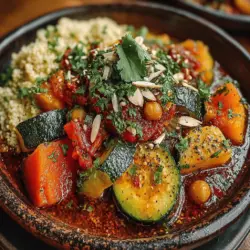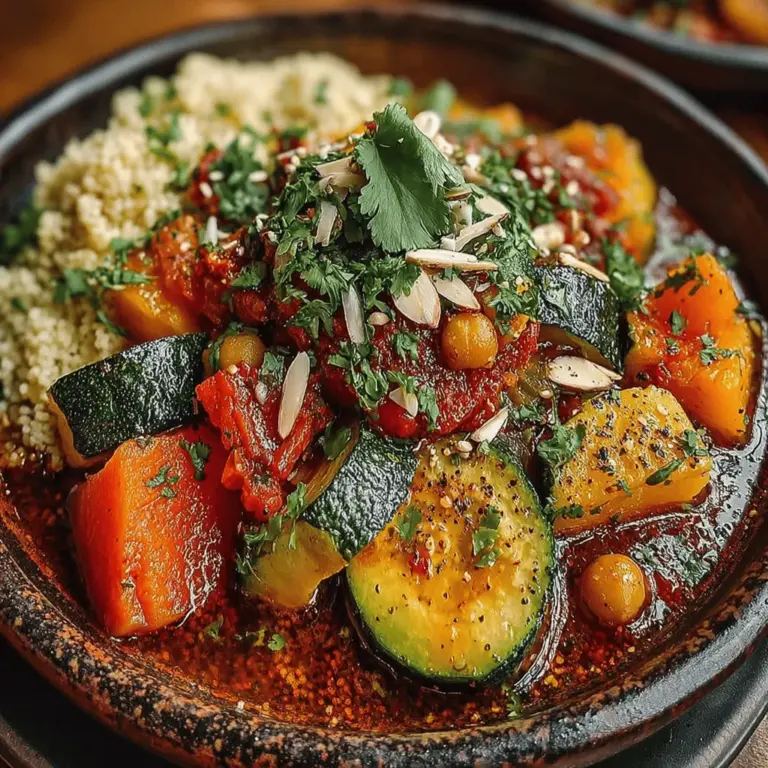Introduction to Moroccan-Spiced Vegetable Tagine
Explore the vibrant world of Moroccan cuisine with this flavorful Moroccan-Spiced Vegetable Tagine. A perfect blend of spices, fresh vegetables, and hearty chickpeas, this dish is not only a feast for the senses but also a nourishing and satisfying meal. Its unique combination of textures and flavors makes it a delightful option for both vegetarians and meat-lovers alike. This article will guide you through the intricacies of creating this delightful dish, diving into the ingredient selection, cooking methods, and cultural significance.
Ingredients
– 1 tablespoon olive oil
– 1 large onion, diced
– 3 garlic cloves, minced
– 1 medium carrot, sliced
– 1 medium zucchini, diced
– 1 red bell pepper, chopped
– 1 cup cauliflower florets
– 1 can (15 oz) chickpeas, drained and rinsed
– 1 cup diced tomatoes (canned or fresh)
– 2 cups vegetable broth
– 1 teaspoon ground cumin
– 1 teaspoon ground coriander
– 1 teaspoon ground cinnamon
– 1/2 teaspoon turmeric
– Salt and pepper to taste
– Fresh cilantro, for garnish
– Lemon wedges, for serving
Instructions
1. Heat the olive oil in a large tagine or heavy-bottomed pot over medium heat.
2. Add the diced onion and sauté until translucent, about 5 minutes.
3. Stir in the minced garlic and cook for an additional minute until fragrant.
4. Add the sliced carrot, diced zucchini, chopped bell pepper, and cauliflower florets. Sauté for about 5-7 minutes, allowing the vegetables to soften.
5. Sprinkle in the ground cumin, coriander, cinnamon, turmeric, salt, and pepper. Stir well to coat the vegetables with the spices.
6. Incorporate the chickpeas and diced tomatoes, stirring to combine all ingredients.
7. Pour in the vegetable broth, bringing the mixture to a gentle simmer.
8. Cover the tagine or pot and let it cook on low heat for 25-30 minutes, or until the vegetables are tender.
9. Taste and adjust seasoning if necessary.
10. Serve hot, garnished with fresh cilantro and lemon wedges on the side.
Understanding the Essence of Tagine
What is a Tagine?
A tagine is both a dish and the traditional cookware used in Moroccan cuisine. The tagine pot, characterized by its conical lid, is designed to circulate steam, ensuring that the ingredients cook evenly and retain moisture. This method of cooking has historical significance in Moroccan culture, with roots tracing back centuries. It allows for the infusion of flavors, making tagines a beloved choice for family meals and special occasions.
The Role of Spices in Moroccan Cuisine
Spices are the heart of Moroccan cooking, adding depth and complexity to dishes. In this recipe, cumin and coriander contribute earthy notes, while cinnamon brings warmth and sweetness. Turmeric not only adds a vibrant color but also offers anti-inflammatory benefits. Understanding the role of these spices is essential for creating a well-balanced tagine that celebrates the rich culinary traditions of Morocco.
Ingredients Breakdown
Essential Components of the Tagine
Each ingredient in Moroccan-Spiced Vegetable Tagine plays a crucial role. The vegetables provide a variety of textures, while chickpeas add protein and heartiness. The spices are essential for achieving the authentic Moroccan flavor profile. For those with dietary restrictions or preferences, substitutions such as quinoa or lentils can replace chickpeas, and a variety of seasonal vegetables can be used.
Fresh vs. Dried Ingredients
Utilizing fresh vegetables enhances the dish’s flavor and texture, allowing for a more vibrant and colorful presentation. Dried fruits, such as apricots or raisins, can be added for a hint of sweetness, balancing the savory spices. This combination of fresh and dried ingredients contributes to the complexity of flavors inherent in Moroccan cuisine.
Cooking Instructions
Step-by-Step Guide to Making Moroccan-Spiced Vegetable Tagine
The cooking process is straightforward, but attention to detail is key. Begin by sautéing the aromatics, which forms the flavor base of the dish. Adding the vegetables in stages allows each to cook properly without becoming mushy. Incorporating the spices at the right moment ensures their flavors bloom, creating a fragrant and flavorful dish.
Tips for Timing and Temperature
Managing the timing and temperature is crucial for optimal results. Cooking on low heat allows the vegetables to become tender while retaining their shape and nutrients. Stir occasionally to prevent sticking, and adjust the heat as needed to maintain a gentle simmer. This careful approach ensures that the Moroccan-Spiced Vegetable Tagine turns out perfectly every time.

Serving Suggestions
Perfect Pairings for Your Tagine
When serving Moroccan-Spiced Vegetable Tagine, the right accompaniments can elevate your meal to new heights. Fluffy couscous is a classic pairing, as its light and airy texture absorbs the flavorful sauce beautifully, making each bite a delightful experience. Alternatively, consider serving the tagine with crusty bread, which can be used to scoop up the vegetables and sauce, adding a satisfying crunch to each mouthful. For a refreshing contrast, a simple salad with lemon dressing or a side of yogurt can help balance the spices, providing a cool, creamy counterpoint to the warmth of the dish.
Presentation Ideas
The visual appeal of your Moroccan-Spiced Vegetable Tagine can greatly enhance the dining experience. Serve the tagine in a traditional Moroccan tagine pot for an authentic look that also retains heat. Garnish the dish with fresh herbs like cilantro or parsley, and scatter some toasted almonds or sesame seeds on top for added texture and flavor. For a colorful presentation, arrange an array of vibrant vegetables around the tagine, or serve individual portions in small bowls, topped with a drizzle of olive oil and a sprinkle of spice to entice your guests.
Nutritional Benefits of the Dish
Health Benefits of Key Ingredients
This flavorful dish is not only delicious but also packed with health benefits. Chickpeas, a primary ingredient, are a great source of protein and fiber, aiding digestion and promoting satiety. The variety of vegetables included—such as carrots, zucchini, and bell peppers—are rich in vitamins and minerals essential for maintaining good health. The spices used in the tagine, such as cumin and coriander, possess anti-inflammatory properties and can enhance metabolism, making this dish a nutritious choice for any meal.
A Balanced Meal
Moroccan-Spiced Vegetable Tagine is an excellent representation of a balanced meal. It contains a good mix of macronutrients, combining protein from chickpeas, healthy carbohydrates from vegetables, and healthy fats if you choose to drizzle olive oil on top. This dish is suitable for various dietary preferences, including vegetarian and vegan diets, making it a versatile option for family gatherings or dinner parties. The wholesome ingredients provide a satisfying meal that can keep you energized throughout the day.
Cultural Significance of Tagine in Moroccan Cuisine
Traditions Surrounding Tagine
In Moroccan culture, tagine is more than just a cooking method; it embodies the spirit of hospitality and communal eating. Traditionally, the dish is served at the center of the table, encouraging everyone to share and enjoy the meal together. This practice fosters a sense of community and connection among family and friends, highlighting the importance of togetherness in Moroccan society. The slow-cooked nature of tagine also reflects the value placed on patience and care in preparing meals.
The Influence of Moroccan Cuisine Worldwide
Moroccan cuisine has made a significant impact on global culinary practices, with tagine dishes gaining popularity far beyond the borders of Morocco. Chefs and food enthusiasts around the world have embraced the unique flavors and cooking techniques, integrating them into diverse culinary traditions. This growing interest not only brings Moroccan flavors to a wider audience but also promotes cultural exchange and appreciation for the richness of different food heritage.
Conclusion: Embracing Moroccan Flavors in Your Kitchen
Cooking Moroccan-Spiced Vegetable Tagine is a journey into the heart of Moroccan culinary traditions, offering a delightful array of flavors and fragrances that can transform any meal. This dish not only showcases the beauty of diverse ingredients but also serves as a bridge to connect people through food. By exploring and enjoying the flavors of different cultures, we foster a deeper appreciation for global culinary practices and create memorable dining experiences that bring family and friends together. Embrace the joy of cooking with Moroccan-inspired dishes and invite the world into your kitchen.

